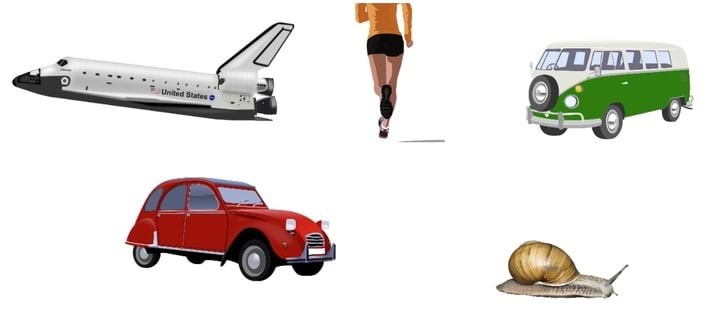Making sure that students have a clear qualitative understanding of speed is necessary before introducing quantitative approaches (Driver et al., 1994a). ‘[Students] need more than a routine manipulation of numbers. They need to think of an object at a greater speed both getting to a particular point in a shorter time and going further in the same time, so as to have an understanding of the practical implications of speed as distance covered in a unit time.’ (Driver et al., 1994b)
When dividing distance by time to calculate average speed different units are involved that combine to form a compound measure. For example, if a ball rolls 8 metres along the ground in 2 seconds, its average speed can be calculated. Here, the division has been done in two steps for emphasis – first the units and then the numbers.
In science, it is good practice always to include units as part of the calculation, in order to keep track of what the numbers mean. (Boohan, 2016)
This question checks students’ qualitative understanding of speed as a measure of distance per unit time, in order to make sure they are ready for calculating averaged speeds.
Students should complete the question individually. This could be a pencil and paper exercise, or you could use an electronic ‘voting system’ or mini white boards and the PowerPoint presentation.
The answers to the question will show you whether students understood the concept sufficiently well to apply it correctly.
If there is a range of answers, you may choose to respond through structured class discussion. Ask one student to explain why they gave the answer they did; ask another student to explain why they agree with them; ask another to explain why they disagree, and so on. This sort of discussion gives students the opportunity to explore their thinking and for you to really understand their learning needs.
Equipment
For the class:
- Metre ruler (a wooden ruler works well)
- Supports for each end of the ruler (e.g. piles of books)
- 2N weight (200g mass) – it is important that it is hard to detect flexing of the ruler when this weight is added, so its size may need to be adjusted to suit the particular equipment used.
- 10N weight (1kg mass)
Differentiation
You may choose to read the questions to the class, so that everyone can focus on the science. In some situations it may be more appropriate for a teaching assistant to read for one or two students.
Statement D is the odd one out because it describes time rather than speed. Some students may think it does describe speed, because in everyday language they may say a journey is ‘fast’ if it does not take very long.
Some students may select either the snail (about 1 cm/s) or the space shuttle (up to 7.8km/s) because they are at the extremes of the speeds of the objects in the list.
If students have misunderstandings about why four statements describe speed and one does not, it can help to discuss, for each statement in turn, how the speed can be worked out from the information given. For D there is no distance – so the minibus could be travelling very quickly over a long distance, or slowly over a short distance.
This is a good point to introduce students to the equation: average speed = distance ÷ time and the units of speed as m/s (the SI unit for speed). Practical work to measure distance and time in order to calculate speeds can help to consolidate understanding, and opportunity to practise calculations is also helpful. For many students it may not be appropriate at this stage to include problems that need the equation to be rearranged. It is worth checking with maths teachers what is appropriate.
The following BEST ‘response activity’ could be used in follow-up to this diagnostic question:
- Response activity: Measuring top speed
Boohan, R. (2016). The Language of Mathematics in Science: A guide for teachers of 11-16 science Hartfield, Herts: Association for Science Education.
Driver, R., et al. (1994a). Making Sense of Secondary Science: Research into Children's Ideas, London, UK: Routledge.
Driver, R., et al. (1994b). Making Sense of Secondary Science: Support Materials for Teachers, London: Routledge.
